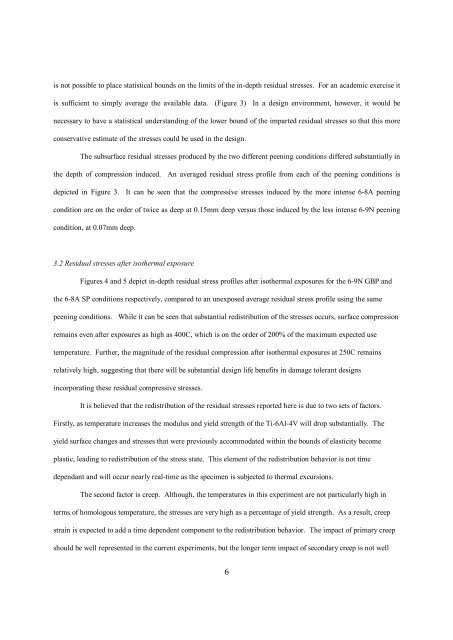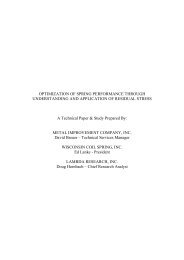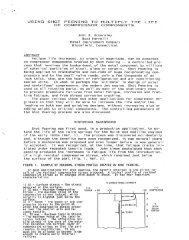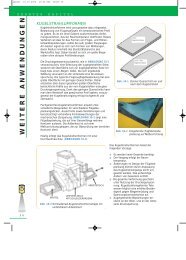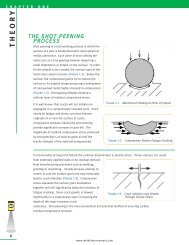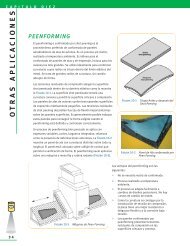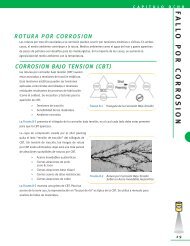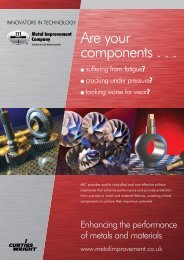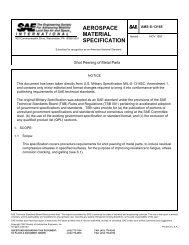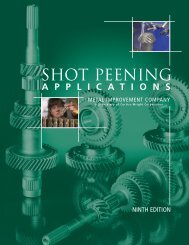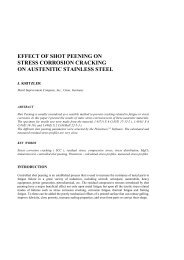Relaxation of Shot Peening Induced Residual Stresses in Ti-6Al-4V ...
Relaxation of Shot Peening Induced Residual Stresses in Ti-6Al-4V ...
Relaxation of Shot Peening Induced Residual Stresses in Ti-6Al-4V ...
You also want an ePaper? Increase the reach of your titles
YUMPU automatically turns print PDFs into web optimized ePapers that Google loves.
is not possible to place statistical bounds on the limits <strong>of</strong> the <strong>in</strong>-depth residual stresses. For an academic exercise it<br />
is sufficient to simply average the available data. (Figure 3) In a design environment, however, it would be<br />
necessary to have a statistical understand<strong>in</strong>g <strong>of</strong> the lower bound <strong>of</strong> the imparted residual stresses so that this more<br />
conservative estimate <strong>of</strong> the stresses could be used <strong>in</strong> the design.<br />
The subsurface residual stresses produced by the two different peen<strong>in</strong>g conditions differed substantially <strong>in</strong><br />
the depth <strong>of</strong> compression <strong>in</strong>duced. An averaged residual stress pr<strong>of</strong>ile from each <strong>of</strong> the peen<strong>in</strong>g conditions is<br />
depicted <strong>in</strong> Figure 3. It can be seen that the compressive stresses <strong>in</strong>duced by the more <strong>in</strong>tense 6-8A peen<strong>in</strong>g<br />
condition are on the order <strong>of</strong> twice as deep at 0.15mm deep versus those <strong>in</strong>duced by the less <strong>in</strong>tense 6-9N peen<strong>in</strong>g<br />
condition, at 0.07mm deep.<br />
3.2 <strong>Residual</strong> stresses after isothermal exposure<br />
Figures 4 and 5 depict <strong>in</strong>-depth residual stress pr<strong>of</strong>iles after isothermal exposures for the 6-9N GBP and<br />
the 6-8A SP conditions respectively, compared to an unexposed average residual stress pr<strong>of</strong>ile us<strong>in</strong>g the same<br />
peen<strong>in</strong>g conditions. While it can be seen that substantial redistribution <strong>of</strong> the stresses occurs, surface compression<br />
rema<strong>in</strong>s even after exposures as high as 400C, which is on the order <strong>of</strong> 200% <strong>of</strong> the maximum expected use<br />
temperature. Further, the magnitude <strong>of</strong> the residual compression after isothermal exposures at 250C rema<strong>in</strong>s<br />
relatively high, suggest<strong>in</strong>g that there will be substantial design life benefits <strong>in</strong> damage tolerant designs<br />
<strong>in</strong>corporat<strong>in</strong>g these residual compressive stresses.<br />
It is believed that the redistribution <strong>of</strong> the residual stresses reported here is due to two sets <strong>of</strong> factors.<br />
Firstly, as temperature <strong>in</strong>creases the modulus and yield strength <strong>of</strong> the <strong>Ti</strong>-<strong>6Al</strong>-<strong>4V</strong> will drop substantially. The<br />
yield surface changes and stresses that were previously accommodated with<strong>in</strong> the bounds <strong>of</strong> elasticity become<br />
plastic, lead<strong>in</strong>g to redistribution <strong>of</strong> the stress state. This element <strong>of</strong> the redistribution behavior is not time<br />
dependant and will occur nearly real-time as the specimen is subjected to thermal excursions.<br />
The second factor is creep. Although, the temperatures <strong>in</strong> this experiment are not particularly high <strong>in</strong><br />
terms <strong>of</strong> homologous temperature, the stresses are very high as a percentage <strong>of</strong> yield strength. As a result, creep<br />
stra<strong>in</strong> is expected to add a time dependent component to the redistribution behavior. The impact <strong>of</strong> primary creep<br />
should be well represented <strong>in</strong> the current experiments, but the longer term impact <strong>of</strong> secondary creep is not well<br />
6


